A Global Sanitation Crisis
The lack of access to safe sanitation is a Global crisis directly affecting over 3 Billion people. It is a greater threat than War and malnutrition and a main cause of communicable and preventable diseases.
Indirectly it affects all of us through Environmental damage and contributing to social dysfunction and prolonged poverty.
EcoRegions and the development of the Demplot site
Please check the Website for information on Ecoregions development
As part of our redevelopment of Indonesian Eco Regions at Tanjung Ringgit, East Lombok and The Eight islands to the North West of West Sumbawa, we have established a permanent demonstration site where we test new appropriate technologies and methods for addressing Environmental and health problems in and around the development area.
This Toilet project follows the training of 30 people from 7 Hamlets in the techniques for Ferro cement water tank construction. The prototype is being built at the 2 Ha Demplot site in a damaged forest area at Tanjung Ringgit
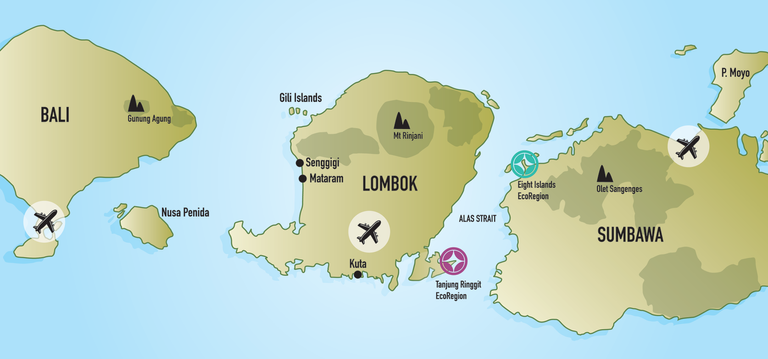
Our two Eco Regions are located in East Lombok (339 Ha) and West Sumbawa (Eight islands), Nusa Tengara province, Indonesia
Toilet customs in Asia
In the West and in Asian, people have become accustomed to flushing away waste. In many Asian countries, the bidet or ladle of water is used to clean oneself after defecation. Toilet paper is only used for drying afterward and is discarded in the wastepaper basket.
After living in Asia for 6 years I find it confronting to use the western toilet paper system again, It's just not clean enough for comfort. I feel unclean like many Asians if all I have available is toilet paper.
Also one needs more water to flush away both toilet paper and waste, and a septic system that can digest it.
Two kinds of septic systems
The Asian septic is most often a rubble pit latrine. a closed top cylinder open at the base, waste flows in and digests with the leachate moving into the groundwater. While this method undoubtedly saves many lives and is preferable to open defecation it is a huge source of bacterial and nutrient pollution to nearby wells, rivers, and coastlines. A short term fix with long term problems.
They cost about $50 in materials and take up only a few square metres.
These systems fare poorly with toilet paper inputs and it significantly shortens their working life
Western off grid sealed septic systems work well and have over 100 years of service worldwide to prove their efficacy. They consist of usually a minimum 1800L anaerobic digestion tank where biosolids undergo anaerobic decomposition and the wastewater that exits is considerably better. The wastewater leads to a designed leach field where it also disperses to the groundwater, a better solution with a longer working life than a rubble pit latrine but still not suitable for heavy soils or nutrient sensitive locations.
They are much more expensive and require much more land area to install.
These systems do accept inputs of toilet paper but it is neither a benefit nor a hindrance
Dry toilets
Modern composting toilets are dry systems. Excreta falls down a chute and is followed by few scoops of carbon-rich organic material such as sawdust that soak up the liquids and balance the Carbon: Nitrogen ratio so that aerobic composting occurs. Toilet paper helps rather than inhibits the process. These systems work very well and generate a compost that recaptures essential nutrients and can be used safely in landscaping.
However, the don't accept wet flushing systems very well. Too much water leads to a stinking anaerobic mess.
It is incompatible with the flush toilet and incompatible with the use of the bidet for cleaning oneself.
Commercial units cost from a few hundred dollars to a few thousand dollars.
The Tiger Toilet
The Tiger Toilet is named for the use of Tiger worms (Eisenia foetida) in the filtration and digestion chamber to decompose biolsolids. It can accommodate a wet toilet system because it has good drainage so it retains the anaerobic function
Biosolids flush to a chamber where they fall onto a bed of organic materials that are bedding for the worms. The liquids drain vertically through charcoal then sand, and the effluent is low in suspended solids.
The worms decompose faeces and toilet paper and they and associated composting microbes consume faecal bacteria and other disease-causing microbes. The effluent can be used for subsurface irrigation in the landscape and provides essential nutrients for ecosystem health.
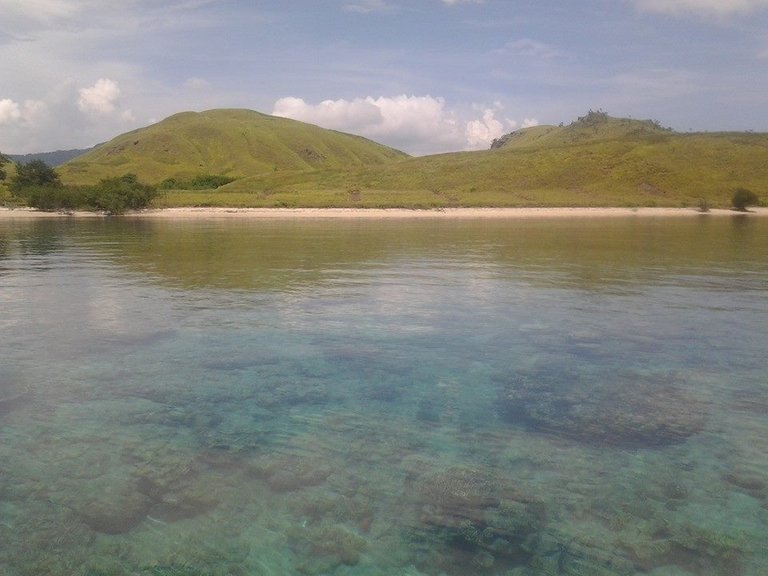
Islands like this are both sensitive to nutrient inputs via conventional toilets, and yet could benefit in the reforestation efforts by controlled placemnet of Wastewater gardens
Mass production using portable Ferro cement moulds
Current systems use readily available bricks, sand, and cement to create the systems. But these are heavy and difficult to transport,
We wanted to modify this using plywood Ferro cement moulds that can be carried anywhere, into remote villages with only motorbike access or onto desert islands.
Ferro cement technology also uses less sand and cement for a much stronger construction, and it can be repaired easily.
We have modified the system for building water tanks in this way from what our team learnt during their training course at the Bali Appropriate Technology Institute (BATI) under the guidance of Mr. Rus Alit.
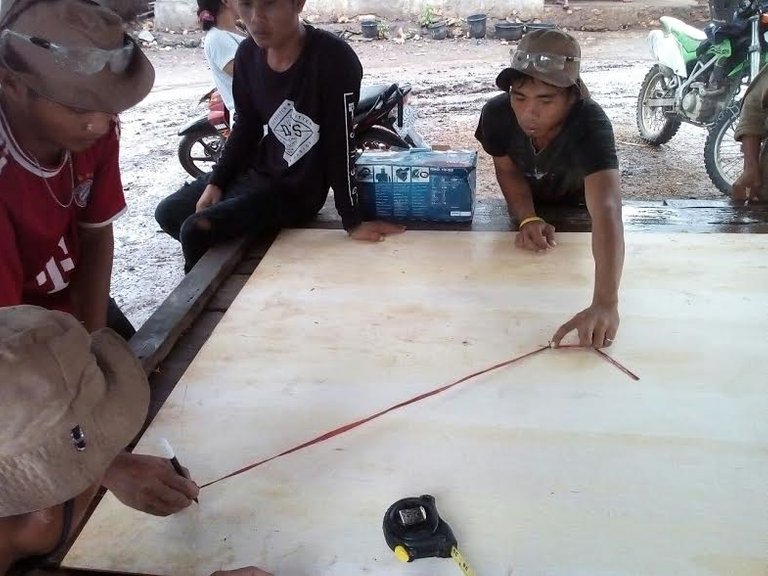
The forms are made of 6mm plywood
The Toilet housing is made using the 5000L water tank moulds and the roof is of Sugar palm fibre thatching
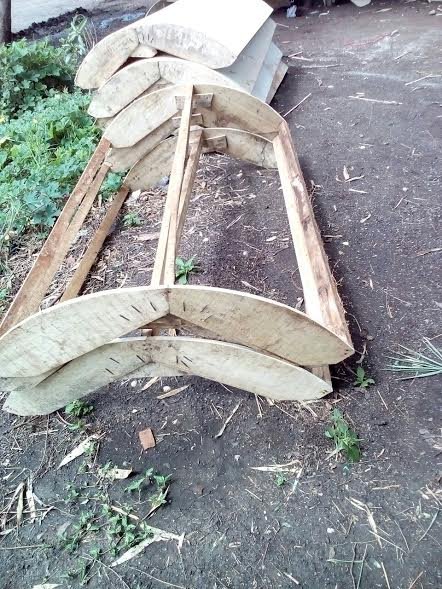
The moulds are made from local Wood used for boat repairs
The worm digester tanks are made using the same technique and are 1.2m in diameter and 1.2m tall.
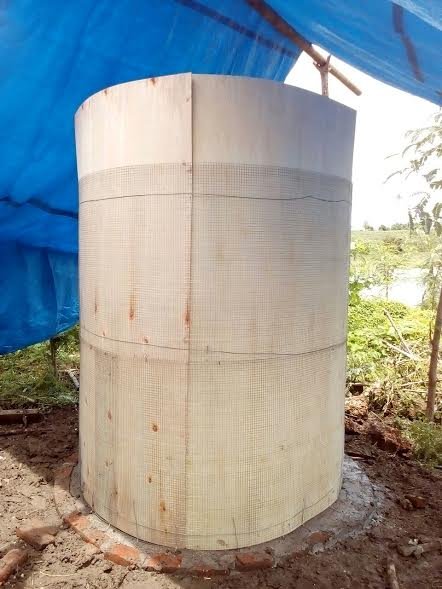
3mm Plywood treated with oil as a releasing agent are used as the outer layer and if well treated can be used make 10-15 times, while the formwork is long lasting
Design
The prototype will serve at our sustainable agroforestry demonstration site to cater for staff and visitors and because the usage is higher than a household unit we are creating two worm digester chambers so that they can be switched to rest for several months in case they need emptying.
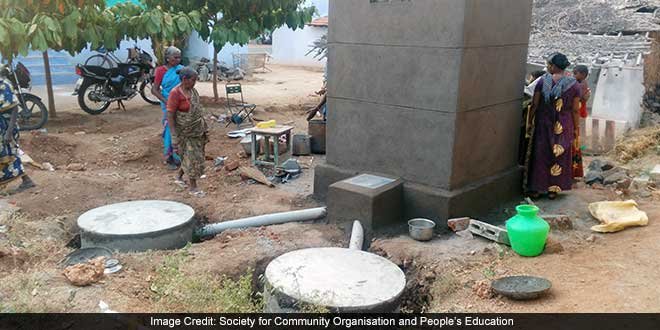
Credit: w.ndtvimg.com/domain/3/2017/05/16133304/tiger-worm-toilet-technology-trichy-tamil-nadu-scope.jpg
The worms in tiger toilets are so effective at digesting solids that preliminary tests show they only need emptying under household conditions every three to five years
Wastewater Gardens - WWG
All the systems discussed earlier do not specifically integrate into their design a way to get benefit from the wastewater from Toilets ( Blackwater) or Showers (Greywater)
Blackwater WWG
This is the water that comes out of the worm digesters and it is rich in nutrients. Some Nitrogen and Phosphorus are trapped in the chamber, either taken up in the worms and microbes bodies or absorbed by evolved humus and the charcoal layer.
The rest are in a liquid solution that flows out of the base of the digester and heads to the WWG.
This Wastewater Gardens' trenches are filled with a thick layer of absorbent organic matter and also inoculated with composting worms.
Surrounding these trenches are species of plant that have a high capacity for luxury nutrient uptake, this refers to the ability to absorb more nutrient than the plant needs to grow. These species can be harvested for mulch or animal fodder as only the roots come in contact with the already treated effluent.
In our tropical area, these plants include Bananas, Canna indica, Vetiver Grass, Elephant grass and clumping Bamboo. In cooler areas, Comfrey and Miscanthus grass are excellent choices.

Mulch harvested from WWG recycles nutrients and enriches gardens with organic matter. This reflective Vietiver mulch is protecting this pumpkin seedling from high surface temperatures.
Greywater WWG
Greywater is water from showers and handwashing. It is only slightly nutrient enriched and in its fresh state contains only moderate amounts of harmful bacteria. It cannot be stored more than 24 hours or else the bacteria bloom and it becomes Blackwater.
Therefore the Greywater exits the wash area and immediately falls into a mulched trench planted in the same manner as the Blackwater system. However, this water can be used for food crops that bear above ground level, including Papaya, Fruit Trees and Vines on a stable trellis above the trench
Please Follow us as we construct the new and improved Tiger Toilet.
if you like what I'm doingplease Comment, Upvote, Share or Resteem!

This definitely looks interesting. Such ideas are much needed and appreciated. Best of luck to you!:)
Hi reville, what interesting work you are doing! Regarding greywater WWG, is it important that people don't use any soaps or chemical cleaners when they wash their hands and take showers, or is the system able to handle small amounts of chemical cleaners? Also, is the blackwater WWG working with flushable toilets?
Yes you can use soaps. What im conerned about as with all WWG are soaps containing the persistent biocide, Triclosan
What we will do is provide a basic soap for people to wash hands. Im thinking we can install a basin, a "Wastafel" outside and that water will go to another location, not to the worm digesters.
For cleaning the toilet there is no need to use harsh chemical cleaners. Some vinegar or again just a basic soap, without antibacterial agents will be provided to maintain it.
To assist in toilet health its sueful to flush some activated EM4 ( effective microorganism , mostly lactobacillus) down the system to help it digest the biosolids.
I dod believe the system can handle some chemical cleaners, but keep it simple.
Yes, the Blackwater system works with a flush toilet and that is the star element of this design, merging the flush toilet front end, with the composting back end. I believe that's the the main impediment to the uptake of composting toilets until now, with the other being the price.Hi @sizzlingmonkeys . Yes you are correct that there is a danger of chemical use, thats another reason we are building a dual chamber system so that if one worm colony is damaged we can switch to the other. Luckily worms are mobile and will move away from negative chemical stimuli. This is all part of the experimentation process
Thanks for the detailed reply! I wonder if this kind of septic system will work in other locations in the world, like other parts of Asia or in Africa? Is it difficult to maintain?
This kind of system has already been tested in parts of Africa, India and other parts of Asia with great success.
Innovations we are adding to it are a) ferro cement construction b) reusable formwork and c) integrated grey and blackwater WWG.
We are making what already works, even better
https://www.slideshare.net/mobile/Oxfamgb/tiger-worm-toilets-oxfam-public-health-engineering-webinar this is a Tiger toilet project in Africa
Some science behind it
https://www.google.co.id/url?sa=t&source=web&rct=j&url=http://www.imperial.ac.uk/media/imperial-college/faculty-of-engineering/civil/public/ug/ug-final-year-projects/2015-16/E19---Liam-David-Noad.pdf&ved=0ahUKEwjr3JK01IrVAhWCNJQKHZD6CI8QFgguMAk&usg=AFQjCNGDvvpnCi3ZLu3Vg8NqWKmNu1xscA
Congratulations @reville! You have completed some achievement on Steemit and have been rewarded with new badge(s) :
Click on any badge to view your own Board of Honor on SteemitBoard.
For more information about SteemitBoard, click here
If you no longer want to receive notifications, reply to this comment with the word
STOPHi Rev, This looks a great system how do you fell the tiger worms will fair in Pemberton (SW of Western Australia) during winter. We are moving down to manage family farms and retrofiting and small house nad designing some kind of eco education spaces in the longer term so keen to come up with an intelligent and mainstream mentally acceptable toilet system. This looks the pick of the bunch from a generally hands off (let nature do (enjoy) the dirty work perspective).
To answer your question, Tiger worms will do just fine there. In fact, they are more at home there than here.
I used to buy tigers and reds at garden centres there.
In Australia the worm cultures sold are often a mix of Reds and Tigers (Eisenia andrei and Eisenia foetida) and they like the cooler temperatures.
I think the Tiger toilet sounded more catchy for the inventors and marketers.
Actually so far in my reading the worm that digests human excreta best seems to be the malay blue (Perionyx excavatus).
You can have mixed cultures and their numbers will change with the seasons and depending on conditions.
Perionyx are subtropical worms and thrive im the summer.
Theres also African night crawlers (Eudrilus eugeniae) for Tropical temperatures.
Ill take a mixed bag.
You can buy all these in Australia via mail order / domestic online shopping
Youll need at least 1 kg of worms to kickstart your system as they eat 0.6-1 x their bodyweight a day and you need enough to be on top of the amount that inflows.
Im going to put up a post on how we do Ghetto vermicomposting without the need for expensive "worm farms" (towers of death, haha)
That way you can build up numbers over time and save money.Hi @terraperma . I know Pemberton :) theres a whole lot of Karri down there planted by my Grandfather :)
Please stay tuned and ill give thought to alternative substrates and insulated concrete for more variable climates
https://steemit.com/permaculture/@reville/evolving-the-tiger-toilet-part-2 https://steemit.com/permaculture/@reville/evolving-the-tiger-toilet-part-3 https://steemit.com/permaculture/@reville/evolving-the-tiger-toilet-part-4